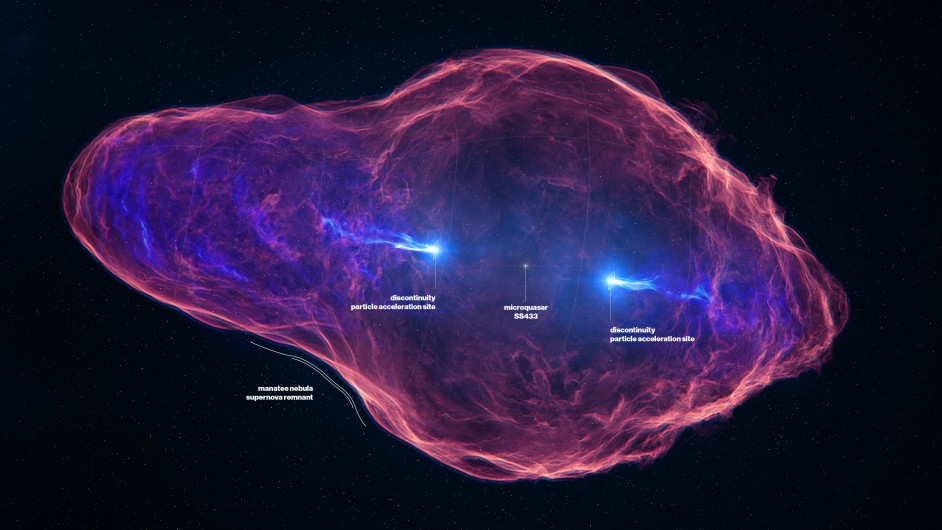First location of a gamma-ray source in a microquasar
 Artist's impression of the SS 433 system, depicting the large-scale jets (blue) and the surrounding Manatee Nebula (red). Credit: Science Communication Lab for MPIK/H.E.S.S.
Artist's impression of the SS 433 system, depicting the large-scale jets (blue) and the surrounding Manatee Nebula (red). Credit: Science Communication Lab for MPIK/H.E.S.S.
Some 18,000 light-years from Earth, in our own galaxy, lies SS 433. This acronym stands for a pair of stars and a black hole. While this system has long been known to astronomers through the emission of light in the X-ray and radio bands, this is the first time that photons in the gamma-ray range have been observed.
In SS 433, the black hole sucks in some of the matter from its companion star, as is common in this type of system. "When this material gradually falls onto the black hole, it forms an accretion disk. Most of it disappears into the black hole, but a small proportion is ejected perpendicularly, within two plasma jets, whose speed reaches a quarter of the speed of light", explains Mathieu de Naurois, CNRS research director at LLR and deputy director of the H.E.S.S. collaboration.
Located in Namibia, the telescopes that make up the H.E.S.S. observatory have detected the emission, in these jets, of very high-energy gamma photons, of a few tens of teraelectronvolts (TeV). To give you an idea: the energy of a photon with a visible wavelength is around one electronvolt, that of an X-ray photon is a thousand times greater, and a gamma photon is a thousand billion times greater. Massive.
But this discovery is not just a new entry in the gamma-ray astronomical zoology bestiary, of which there are already several hundred. Thanks to the particular position of SS 433 in the sky, scientists have been able to determine precisely, for the first time too, where these gamma-ray photons were produced. Contrary to what one might naively think, they are not accelerated at the source of the jets, close to the black hole, where velocity is highest. On the contrary, the phenomenon occurs at great distances (over 75 light-years from the black hole). At this distance, the jets, which had disappeared, suddenly re-emerge with X-rays and gamma rays. The hypothesis: they collide with an obstacle, probably a cloud of matter. This collision may accelerate particles, especially electrons, which then transmit their energy to photons.
"The measurements are consistent with the theory," comments Mathieu de Naurois. What's more, the most energetic photons are emitted at the point of impact, and the particles gradually lose energy downstream". With this discovery, astrophysicists are gaining a further insight into the mechanisms of cosmic particle accelerator, which are always more efficient than those built on Earth.
Video : https://www.youtube.com/watch?v=gsVb96q-KRw
The scientific publication: https://www.science.org/doi/10.1126/science.adi2048
More information : https://llr.in2p3.fr/IMG/pdf/ss433_pr_en.pdf
*LLR: a joint research unit CNRS, École Polytechnique, Institut Polytechnique de Paris, 91120 Palaiseau, France
 Support l'X
Support l'X